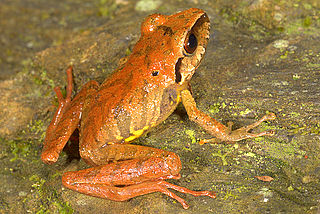
The Eleutherodactylidae are a family of direct-developing frogs native to northern South America, the Caribbean, and southernmost North America. They are sometimes known under the common name rain frogs. Formerly the subfamily Eleutherodactylinae of the family Leptodactylidae, it was raised to the family status following a major revision of New World direct-developing frogs in 2008. As currently defined, the family has more than 200 species.

Adelophryne is a genus of frogs in the family Eleutherodactylidae. They are native to northern South America east of the Andes, known roughly from the area corresponding to the Guiana Shield, as well as to the coastal area of Bahia, Brazil. Whether the genus is truly distinct from Phyzelaphryne remains uncertain. Common name shield frogs has been proposed for this genus, although the stem flea frog is used for some species.

Conraua, known as slippery frogs or giant frogs is a genus of large frogs from sub-Saharan Africa. Conraua is the only genus in the family Conrauidae. Alternatively, it may be placed in the family Petropedetidae.

The golden banana frog, golden dwarf reed frog, golden spiny reed frog, or golden leaf-folding frog is a species of frog in the family Hyperoliidae. It is found in lowland coastal plains of eastern South Africa, Eswatini, and southern Mozambique. The AmphibiaWeb includes Afrixalus crotalus in this species as a subspecies, whereas the Amphibian Species of the World and the IUCN Red List of Threatened Species treat A. crotalus as a full species.
Callixalus is a genus frogs in the family Hyperoliidae. It is monotypic, being represented by a single species, Callixalus pictus. It is found in the eastern Democratic Republic of the Congo and western Rwanda. It is sometimes known as the African painted frog.

Leptopelis broadleyi is a species of frog in the family Arthroleptidae of uncertain status. The Amphibian Species of the World, the IUCN SSC Amphibian Specialist Group, and the African Amphibians do not recognize it, but instead consider it synonym with Leptopelis argenteus. However, the AmphibiaWeb recognizes it as a valid species.

Leptopelis macrotis, sometimes called the big-eyed forest tree frog, is a species of frog in the family Arthroleptidae. It is found in the rainforests of Sierra Leone, southern Guinea, Liberia, Ivory Coast, and southern Ghana. Notice that similar common name "big-eyed tree frog" is sometimes used for Leptopelis vermiculatus from Tanzania and for Litoria exophthalmia from New Guinea.
Adelophryne adiastola is a species of frog in the family Eleutherodactylidae. It is found in the Amazon Basin in Colombia, Ecuador, Peru, and western Brazil.
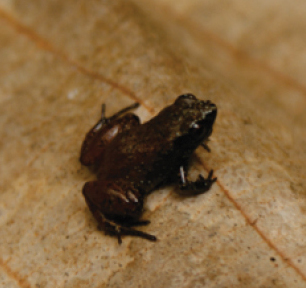
Adelophryne gutturosa is a species of frogs in the family Eleutherodactylidae. It is found on the Guiana Shield from eastern Venezuela through Guyana to French Guiana and adjacent Brazil (Amapá), possibly extending to Suriname. Its type locality is Mount Roraima. Its local Spanish name is ranita guturosa.
Eleutherodactylus inoptatus is a species of frog in the family Eleutherodactylidae endemic to Hispaniola; it is found both in Haiti and the Dominican Republic. With female snout–vent length of about 88 mm (3.5 in), it is the largest eleutherodactylid frog.

Eleutherodactylus intermedius is a species of frog in the family Eleutherodactylidae endemic to eastern Cuba where it is known from the Sierra Maestra and Sierra del Cobre. Its common name is Pico Turquino robber frog, in reference to its type locality.
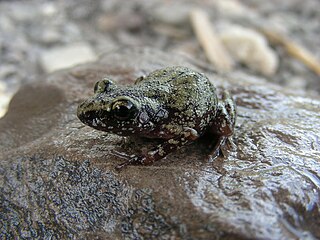
Eleutherodactylus pipilans is a species of frog in the family Eleutherodactylidae. It is found in southern and southeastern Mexico and southwestern Guatemala.
Eleutherodactylus rufescens, commonly known as the red peeping frog or Nevado de Colima chirping frog, is a species of frog in the family Eleutherodactylidae. It is endemic to Mexico and known from the region of the eponymous Nevado de Colima mountain in Colima, Jalisco, and further east and south in the Jalisco and Michoacán states. Its natural habitat is subtropical or tropical moist montane forests. It is threatened by habitat loss.
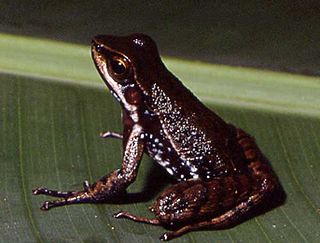
Hylodes heyeri is a species of frog in the family Hylodidae. It is endemic to Brazil. Its natural habitats are subtropical or tropical moist lowland forest, subtropical or tropical moist montane forest, rivers, and subterranean habitats on the Atlantic side of the country. It is threatened by habitat loss.
Hylodes vanzolinii is a species of frog in the family Hylodidae.
Pleurodema bibroni is a species of frog in the family Leptodactylidae. Its common name is four-eyed frog, although this name can also refer to the genus Pleurodema in general. The common name refers to two inguinal poison glands that resemble eyes. When threatened, the frog lowers its head and raises its rear. When the frog adopts this posture the poison glands are also raised toward the predator. The predator may also confuse the frog's raised posterior for the head of a larger animal.

Dermatonotus is a genus of frogs in the family Microhylidae. It is monotypic, being represented by the single species, Dermatonotus muelleri, commonly known as Muller's termite frog. It is found in Argentina, Bolivia, Brazil, and Paraguay.

The Hogsback frog, or Rattray's forest frog, is a species of frog in the family Pyxicephalidae. It is one of three species within the genus Anhydrophryne. It is endemic to the Eastern Cape province of South Africa.
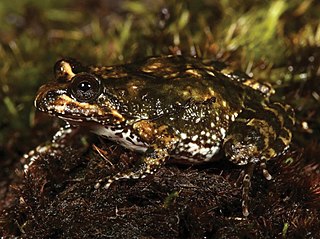
Nothophryne broadleyi is a species of frog in the family Pyxicephalidae found on Mount Mulanje (Malawi). It was monotypic within the genus Nothophryne until four new species were described in 2018.
Phyzelaphryne nimio is a species of frog in the family Eleutherodactylidae. It is endemic to Brazil where it is found in the Japurá River basin. It is a poorly known species, only discovered on one river bank.













